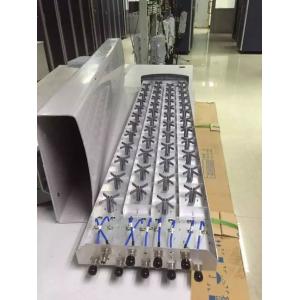Cellular / Mobile Base Station Antenna 15-25° Polarization FAD Listed
Add to Cart

Adopt time/space/frequency three-dimensional rapid wireless resource allocation to ensure system throughput and quality of service. It is convenient, easy to maintain, saves the following deployment investment of D band antenna and reduces the cost of construction station.
Electrical parameters:
1.Frequency range: 1885-1920MHz 2010-2025MHz 2075MHz-2635MHz
2.Electrical down-tilt range: 15-25°
3.Electrical accuracy: ±1
4.Coupling factor between gauged terminal and all radiate terminals: -26±2dB
5.Maximum altitude deviation between gauged terminal and all radiate terminals: ≤0.7dB
6.Maximum phase deviation between gauged terminal and all radiate terminals: ≤5°
7.VSWR between gauged terminal and all radiate terminals: ≤1.5
8.Average power capacity: ≥25W
9.The isolation between the homo-polarized radiation ports: ≥25dB
10.The isolation between the hetero-polarized radiation ports: ≥28dB
11.The isolation between internal combiners FA/D: ≥30dB
12.Horizontal half power beam width: 70°±15
13.Unit beam gain: ≥13.5dBi
14.±60° beam margin power decrease: 12±2dB(2075-2635MHz)
15.Vertical half power beam width: >5°(2075-2635MHz)
16.Cross polarization ratio (axis direction): ≥18dB
17.Cross polarization ratio (±60°): ≥10dB
18.Front-to-back ratio: ≥23dB
19.Upper side-lobe restrain: ≤-15dB(2075-2635MHz)
20.Horizontal half power beam width: 65±5°
21.Broadcast beam gain: ≥13.5dB
22.±60° margin power decrease: 12±2dB
23.Vertical half power beam width: ≥5°
24.Cross polarization ratio (axis direction): ≥18dB
25.Cross polarization ratio (±20°): ≥20dB(1885-1920MHz)≥22dB(2075~2635)MHz
26.Front-to-back ratio: ≥28dB
27.Cross polarization ratio (±60°): ≥8dB
28.Upper side-lobe restrain: ≤-15dB
29.First Down Null-Fill : ≤-18dB
30.0° pointing beam gain: ≥19.5dB
31.0° pointing beam horizontal half power beam width: ≤29°
32.0° pointing beam horizontal side-lobe electrical level: ≤-12dB
33.±60° pointing beam gain: ≥17dB
34.±60° pointing beam horizontal half power beam width: ≤32°
35.±60° pointing beam horizontal side-lobe electrical level: ≤-5dB (1885-1920 and 2010-2025MHz) ≤0dB(2075-2635)
36.0° cross polarization ratio (axis direction): ≥22dB
37.0° front-to-back ratio: ≥28Db
Basic mechanical performance:
1. Interface type: 2 x (4+5)
2. Product size: 1600 * 320 * 140mm.
3. Packing size: 1870 * 330 * 160mm.
4. Product weight: 25kg.
5. Packing weight: 32kg.
6. Wind load area: 0.42 m squared.
7. Wind resistance: 60 m/s.
8. Antenna covers material: UPVC.
9. Interface location: bottom.
10. The mechanical Angle: 0 ~ 10 °
11. Working temperature: 55 ~ + 65 ℃
12. Pole mounted: 50 ~ 115mm.
13. Polarization modes: plus or minus 45 °
14. Input impedance: 50 Ω
15. Protection level: IP55
16. Lightning protection: direct current grounding
Product features
1. Flexible support 1,3,5,10,15,20MHz bandwidth;
2. Adopt OFDMA on the downlink, with a high speed of 100Mbits/s could meet the requirements of high-speed data transmission;
3. The uplink adopt OFDM derivative technology SC - FDMA (single carrier frequency division multiplexing), at the same time of guarantee the performance of the system can effectively reduce the peak ratio (PAPR), decrease the terminal transmission power, extend the service time, uplink rate up to 50M bits/s;
4. Make full use of the features of channel symmetry and other TDD to improve system performance while simplifying system design;
5. The upper level of the system is generally consistent with the FDD system;
6. Combine the smart antenna with MIMO technology to improve the performance of the system in different application scenarios;
7. Use smart antenna technology to reduce inter cell interference and improve the service quality of the marginal users;
8. Adopt time/space/frequency three-dimensional rapid wireless resource allocation to ensure system throughput and quality of service.
9. Convenient, easy to maintain, saves the following deployment investment of D band antenna and reduces the cost of construction station.
Product feature:
GSM is a cellular network which means mobile phones have to connect to the nearest cellular unit area that they could search. GSM network operates on multiple wireless radio frequencies.
There are four different Cellular sizes in GSM network: Macro cell, Microcell, Pico cell and femto cell. The coverage area varies depending on the different environments. The Macro cell could be seen as a base station whose antennas be mounted on a mast or on top of a building. Microcells are those that have a height below average building height and generally be used in urban areas. A Pico cell is a very small cellular that covers only a few tens meters, mainly indoors area. The femtocell is used to cover smaller blind area of cellular networks, filling the gap between the cells. The radius of the cellular can range from a few tens meters to Dozens of kilometers, depending on the height, gain and propagation conditions of the antennas. The actual long-distance GSM specification is supported to 35 km. There is also the concept of expanding the cellular, which increase the coverage by double or even more. GSM also supports indoor coverage, and the power distributor can distribute the power of the outdoor antenna to the indoor antenna distribution system. This is a typical configuration scheme to meet the requirement of indoor high-density call, which is very common in shopping center and airport. This is not obligatory, because indoor coverage functions can be achieved by wireless signals through buildings, however the indoor distribution system could improve signal quality and reduce interference and echo with the features of High power, good quality, easy maintenance, clear communication and good confidentiality.




